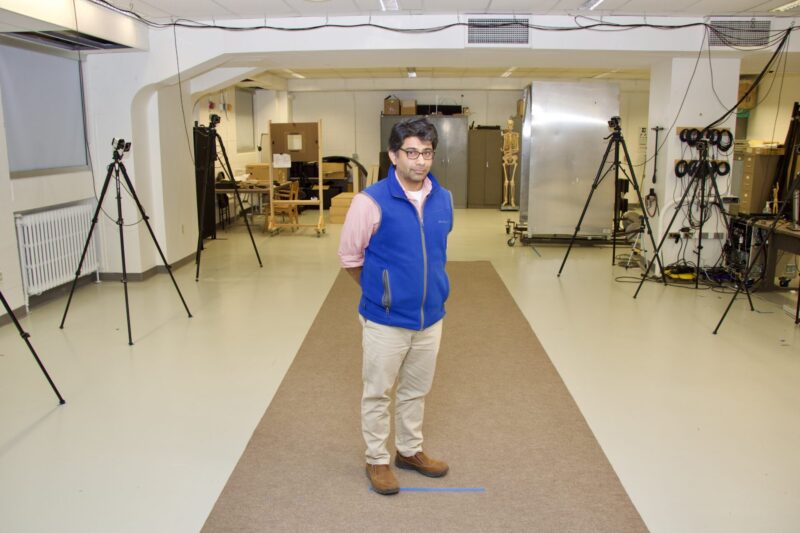Purdue Health and Kinesiology researcher focuses on the biomechanics of Parkinson’s disease

Satya Ambike, an associate professor in the Purdue University Department of Health and Kinesiology, stands in the Purdue Health and Kinesiology Biomechanics Lab.Tim Brouk
Written by: Tim Brouk, tbrouk@purdue.edu
The thrust of Satya Ambike’s research focuses on the biomechanics and control of “task switching” in Parkinson’s disease (PD) as well as finding easier ways of differentiating the neurodegenerative disorder from common physical issues — such as avoiding obstacles while walking — that come with old age.
Ambike, an associate professor in the Purdue University Department of Health and Kinesiology (HK), is collaborating in multiple ongoing projects on physical ailments that present themselves in most PD patients — impaired dexterity or hand strength, and less adaptable locomotion or walking.
Too many physicians diagnose PD with just an “eye test,” according to Ambike. With data collection and machine learning, the Purdue researcher wants more quantifiable, data-driven measures to detect when a patient has early signs of Parkinson’s and not just physical ailments that come with old age.
“Most people with PD are older individuals, so there are going to be movement characteristics that come with aging and those that are because of the pathology, and it is important to know the difference between the two,” Ambike said.
Locomotion
Task switching is an important characteristic of all movement. Ambike used the example of a long jumper’s sprint before executing their giant leap for Olympic gold. The athlete first runs full speed, but then switches to precisely place their feet at the end of the sprint and jump without crossing the foul line. Patients with PD tend to make such switches differently in a way that indicates less adaptable or agile movements.
While walking straight and then stepping over an obstacle, “Most people gradually prepare and then change their gait. But for people with PD, it seems they have a different way of doing that switching, and that different way has its drawbacks,” Ambike noted. “These high-risk individuals don’t show that preparation. That can have consequences to activities of daily living.”
In his collaboration with Peter Altenburger at IU Indianapolis, Ambike observed study participants with PD show concern with where their feet land when they are far away from the obstacle. His locomotive research aims at understanding how PD patients approach and negotiate obstacles like steps and stairs.
“It seems people with PD have trouble switching between two kinds of behaviors,” Ambike concluded.
Dexterity
Another arm of research studies the manual dexterity and strength in those with PD. In a recent project, a control group and a group of people with PD pressed down with their fingers to exert force on a sensor. Like a video game, the individual had to press down hard enough to hit a target on the computer screen.
Both groups did OK in this task if the target was visible. But when the visual target or “visual feedback” was taken away, PD patients’ strength dropped by 50%.
“They cannot exert as much good force as healthy individuals can,” Ambike said. “Force drops when visual feedback vanishes. It is really hard for them to maintain that force. We suspect this is not good.”
In another version of this game, individuals had to switch from producing a constant force to producing a quick-force pulse. Healthy individuals show a gradual progression toward executing the switch, but people with PD do not — just like the observation in the locomotion study.
“We observe similar patterns in movements performed with part of the body and with the whole body. This is a strong indication that PD leads to the impaired control of agility — the ability to effectively change our movements as needed.”
This work could be spun as another way to differentiate people with weakening dexterity caused by old age from those who could have PD.
Discover more from News | College of Health and Human Sciences
Subscribe to get the latest posts to your email.